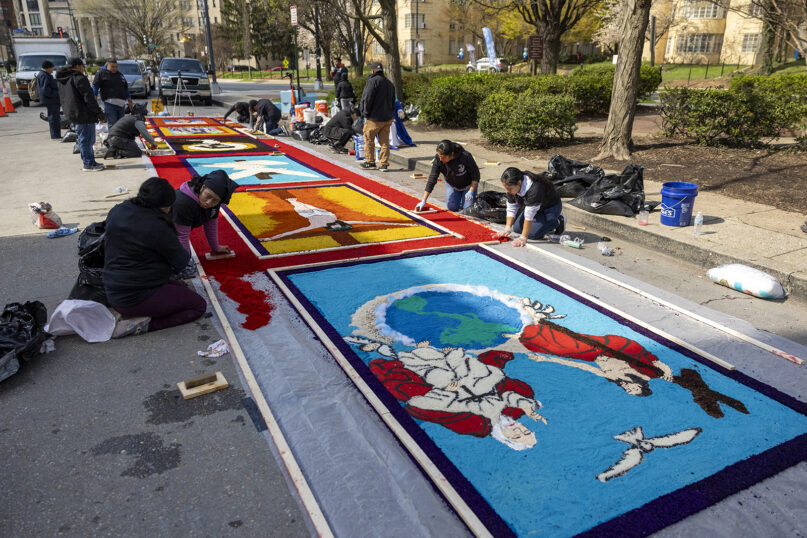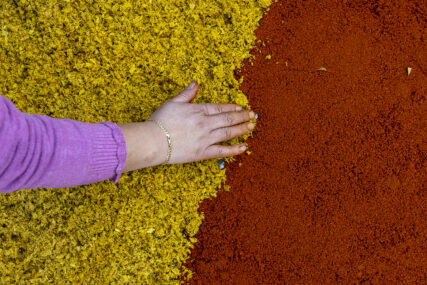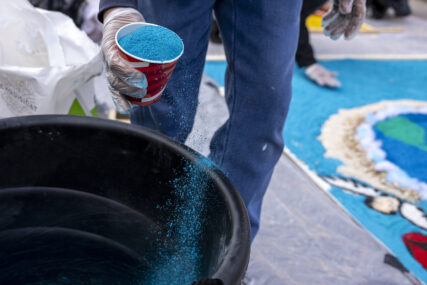WASHINGTON (RNS) — Ubaldo Sánchez kneels on the street beside his 15-year-old nephew, Kevin, spreading colored sawdust to create a bright blue sky above the figure of Jesus. Since 5 a.m. on this Good Friday (March 29), Sánchez, his family and other members of his Maya Mam community have been working in the shadow of the Catholic Shrine of the Sacred Heart, constructing a vibrant “alfombra de aserrín,” or sawdust carpet, filled with Catholic and Maya imagery.
After the 80-foot-long alfombra is completed at about two in the afternoon, some of the 20 or so Indigenous Maya artists, who call themselves Guate-Maya, stayed to guard its perfection until sundown, when a Good Friday procession walked over the carpet, blending the sharply contrasting colors and sweeping that perfection away.
Sawdust carpets are made throughout Guatemala and other parts of Latin America. In Guatemala, they are constructed every Sunday during Lent and for Holy Week processions. Alfombras are a tradition of Sánchez’s Mam people, an Indigenous group from southern Mexico and Guatemala’s western mountains, consider, and he brought the art with him when he came to the U.S. more than 20 years ago.
The history of the alfombras is not well documented, said Yolanda Alcorta, an expert in Latin American art who often collaborates with Sánchez, noting that a 16th century Spanish priest ordered the burning of much of the Maya’s written records. But different theories link the art form to both Mayan traditions of sprinkling flowers before rulers and other traditions brought from Spain.

Julia Sánchez, from left, Mariela Marroquin and Kevin Cabrera-Sánchez help create a sawdust carpet, or alfombra, in Washington, D.C., Friday, March 29, 2024. (RNS photo/Amanda Andrade-Rhoades)
Julia Sánchez, Ubaldo’s sister, said bringing her three U.S.-born children to make alfombras is an important way to connect them to their heritage, in addition to practicing other Maya traditions like playing the marimba.
“The creative work of the group Guate-Maya is a tremendous blessing every Good Friday,” said the Rev. Emilio Biosca Agüero, a Capuchin Franciscan priest and the pastor at Sacred Heart. “Good Friday is such an intense day, thinking about the passion and the death of Christ, and the beauty of this alfombra is reminding you that the story doesn’t end there.”
The alfombras reveal “the greatness and beauty of sacrificial love and the glory of the imminent resurrection,” said Biosca. “There is hope even in the midst of suffering.”
While about 90% of the parishioners at Sacred Heart, in D.C.’s Columbia Heights neighborhood, speak Spanish, with Guatemalans making up one of the large groups of Latin American parishioners, which include people from El Salvador, Honduras and Mexico, Biosca said. The parish also serves parishioners who speak English, Haitian Creole, Vietnamese and Portuguese.
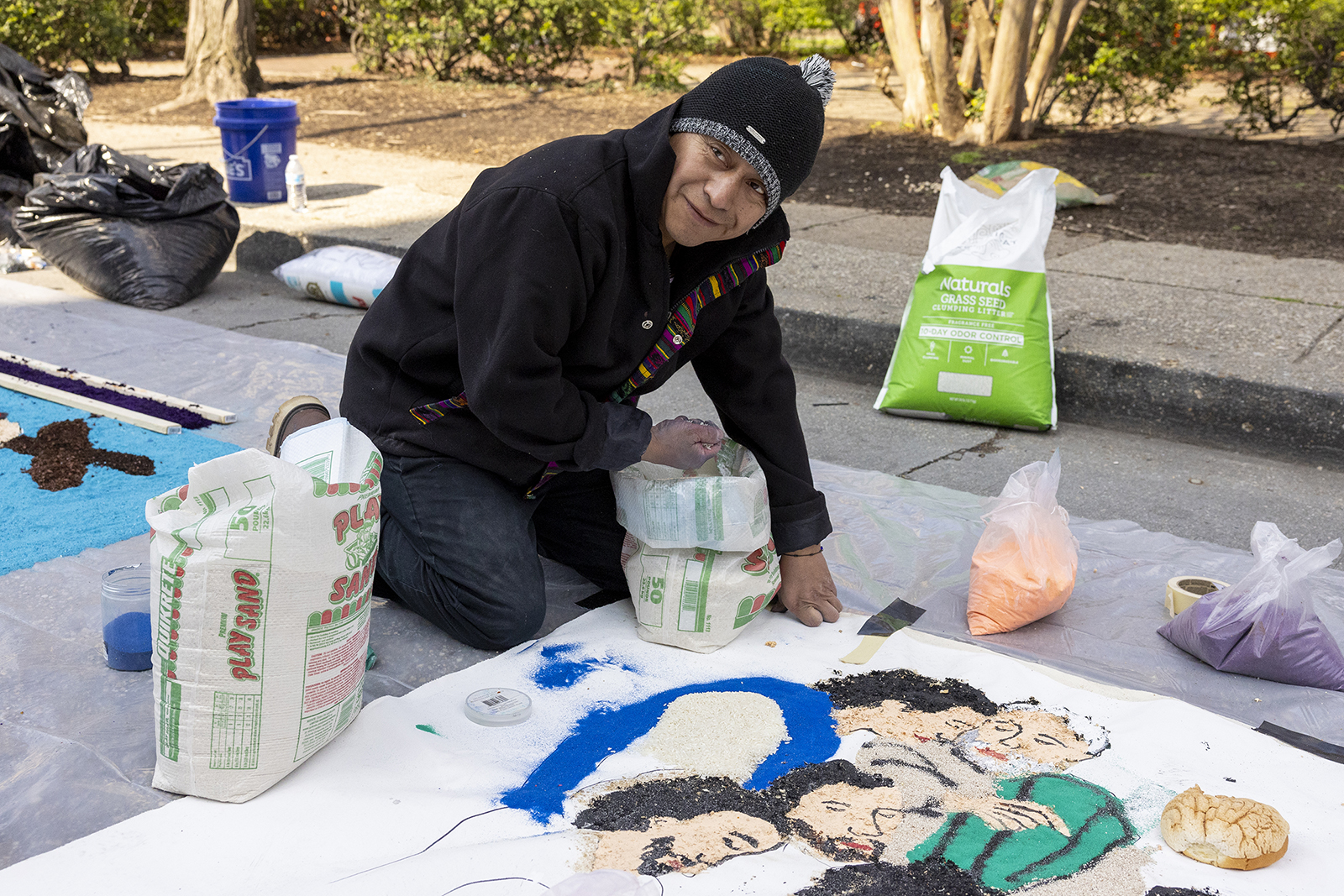
Artist Ubaldo Sánchez pauses while working at Shrine of the Sacred Heart in Washington, D.C. on Good Friday, March 29, 2024. (RNS photo/Amanda Andrade-Rhoades)
During the creation of the alfombra, however, Spanish takes a backseat to the Mam language. Many of the Guate-Maya artists grew up in Concepción Chiquirichapa in the Guatemalan department of Quetzaltenango. There, the alfombras were traditionally made from flowers, pine needles and fruit, but by the time Sánchez began making them for competitions at his school, alfrombras also incorporated sawdust, he said.
He recalls his first Good Fridays in the U.S. as “practically dead.” “People only went to Mass and then it was over,” he said, explaining that people had to work.
Sánchez also paints and creates sculptures and murals. His painting New Dawn was part of President Barack Obama’s White House collection.
When a priest at the Cathedral of Saint Thomas More in Arlington, Virginia, commissioned one of his paintings, Sánchez suggested that he and his friends make an alfombra for the church. “Your community looks sad,” he told the priest.
Like his sister, Sánchez also wanted to involve the younger generation in Maya traditions, including showing appropriate respect when greeting elders. In the U.S., he said, “Everything is strange. We don’t even know our neighbors.”
Later, Sánchez and his group began to make alfombras at St. Anthony of Padua Roman Catholic Church in nearby Falls Church. Now, another group has taken over making St. Anthony’s alfombras. Yet another group creates alfombras at St. Camillus Catholic Church in Silver Spring, Maryland.
Sánchez said Guate-Maya has created alfombras at the National Museum of American History and the Folklife Festival, among other Smithsonian Institution events.
Alcorta, co-founder of Raíces Culturales Latinoamericanas, a nonprofit that promotes Latin American arts, said the alfombras are “a really great community builder.” She sees the alfombra events as a sign that more Guatemalan immigrants have gotten beyond the survival mode that requires them to work two or three jobs after arriving in the U.S. “Now they can turn their attention to doing a tradition,” she said.
- Colored sawdust is compacted to create a carpet, or alfombra, at Shrine of the Sacred Heart on Good Friday, March 29, 2024. (RNS photo/Amanda Andrade-Rhoades)
- Kevin Cabrera-Sánchez, 15, scoops colored powder to add to sawdust on Friday, March 29, 2024. (RNS photo/Amanda Andrade-Rhoades)
Much of the work for the alfombras is done weeks ahead of time. The most difficult part is dying the sawdust, Sánchez said, while cutting the wooden stencils for the borders of the carpets requires patience and precision.
On Good Friday, Alcorta said, the hours spent kneeling to create the alfombras are “a show of faith.”
While Alcorta said she can’t get down on her knees to work on the alfombras like she used to, she still helps assemble the supplies. She has imported materials on her yearly trips to Guatemala, cutting up large stencils to fit in her suitcase and packing another with several kilos of stinky aniline dyes to color the sawdust.
In addition to sawdust, Guate-Maya has used fruit, flowers, rice and even kitty litter to make their alfombras.
Materials can become expensive, Alcorta said, so Guate-Maya puts donation boxes out when they make the carpets. If any money is left over, the group has donated to people struggling with medical or legal bills and once sent some to Guatemala to fund helicopters to fight a forest fire, Sánchez said.
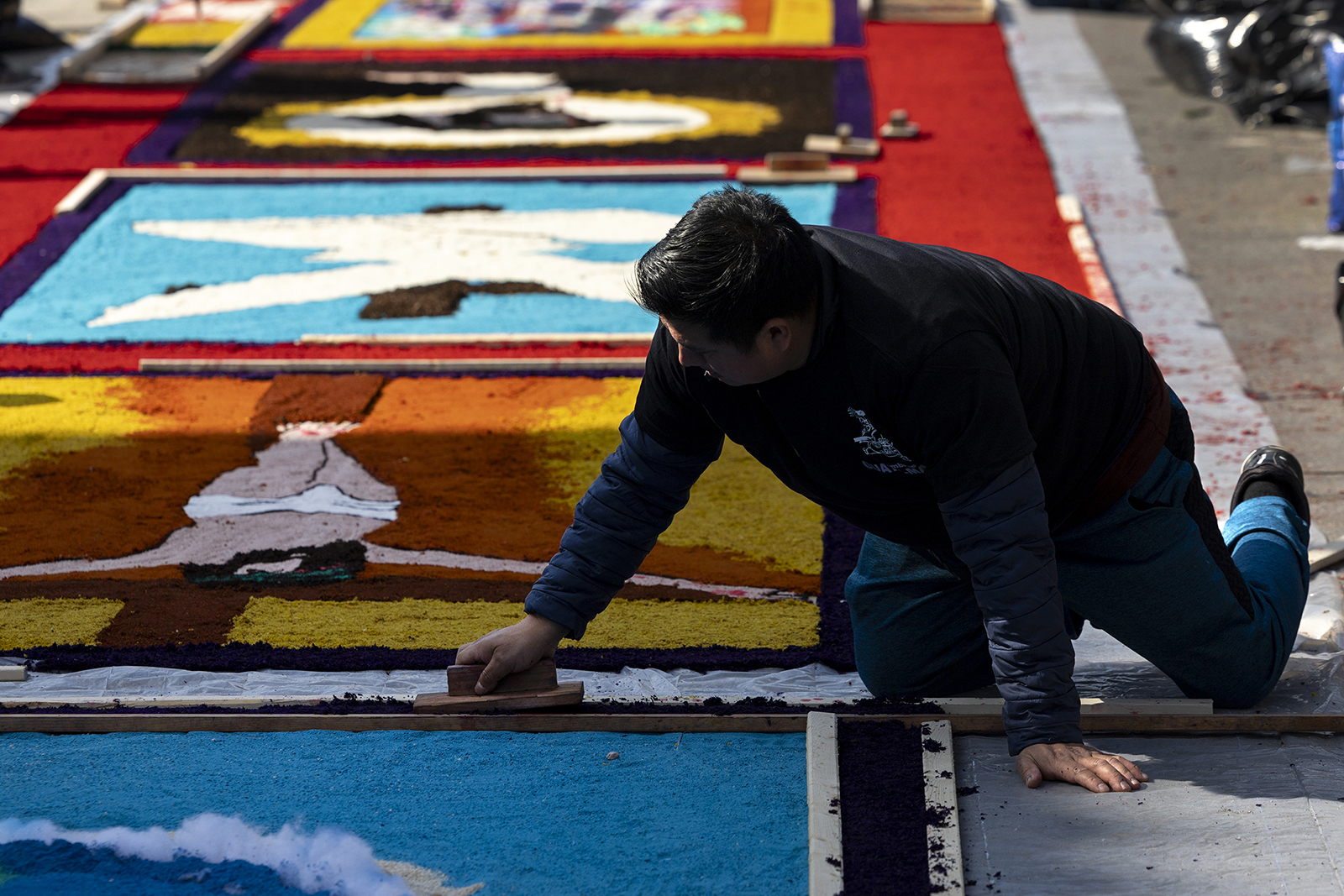
An artist presses down colored sawdust to create an 80-foot-long alfombra at Shrine of the Sacred Heart in Washington, D.C., Friday, March 29, 2024. (RNS photo.Amanda Andrade-Rhoades)
But, Sánchez said the community also pitches in, considering their work on the carpets a gift to Sacred Heart.
In the United States, said Biosca, where so many people are turning away from religion, the beauty of the alfombra reaches beyond the church walls. As Guate-Maya works, community members stop by to ask questions or tell the artists they are glad to see them back.
For those who didn’t grow up with the tradition, walking over time-intensive artwork can seem counterintuitive. Biosca, who has been at Sacred Heart for five years, remembers asking Guate-Maya artists, “Are you sure you want me to walk over this alfombra after you spent all day and so many hours making it?”

A colorful sawdust carpet, or alfombra, is seen before a Good Friday procession organized by Shrine of the Sacred Heart in Washington, D.C., Friday, March 29, 2024. (RNS photo/Amanda Andrade-Rhoades)
The alfombra on Good Friday is one of many ways the parish tries to honor different traditions people remember from their homes.
Biosca said promoting a synthesis between faith and culture is a way of following a teaching of St. John Paul II, who wrote, “A faith that does not become culture is not fully accepted, not entirely thought out, not faithfully lived.”
On Good Friday, Guate-Maya’s alfombra was just one piece of a day laden with liturgy and events. By sunset, 10 different Good Friday events had taken place on the grounds, including a Passion play reenacting Jesus’ crucifixion, the Stations of the Cross in two languages and a Good Friday liturgy in four languages.
Now, as Biosca, wearing an image of the Virgen of Guadalupe, the other priests, sisters and parishioners mustered their energy, it was time for the procession. The afternoon had brought strong gusts of wind, and the precise edges of the colors on the alfombra were bleeding together.
With incense thick in the air, altar servers and young adults who acted in the Passion play gathered in front of the alfombra in their costumes, followed by parishioners carrying nails, a crown of thorns and other objects associated with the crucifixion. Around the alfombra, parishioners carried 35 different banners, each with one of Jesus’ last seven utterances from the cross, in all five parish languages.
Right behind the alfombra, men in two lines bore a float on their shoulders with a statue of Jesus in the tomb. As the Guatemalan marching band behind them began to play a funeral dirge, they took swaying steps forward together onto the alfombra.
The reverent feet of the bearers of the grieving Virgin Mary, John the Apostle and Mary Magdalene followed, blurring the alfombra until the imagery could no longer be seen.
As the faithful streamed after them, the artists in Guate-Maya blended into the crowd.
Earlier, Ubaldo Sánchez said that he had never before experienced wind like that with an alfombra, but he wasn’t worried.
“Everything is fine,” he said. “We do it all for the Lord.”

Parishioners trample the colorful alfombra during a Good Friday procession organized by Shrine of the Sacred Heart in Washington, D.C. (RNS photo/Amanda Andrade-Rhoades)
